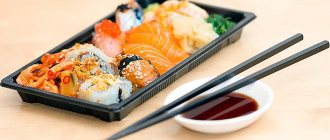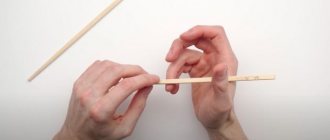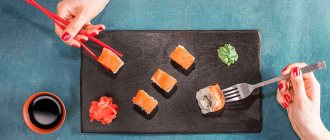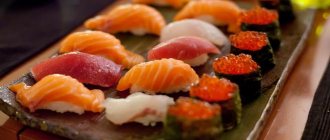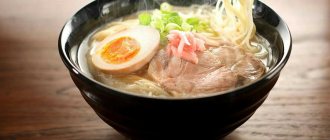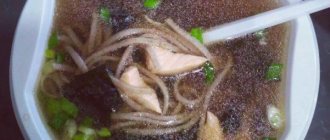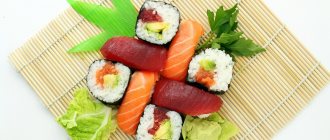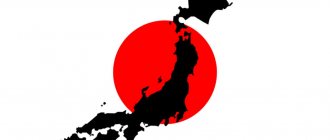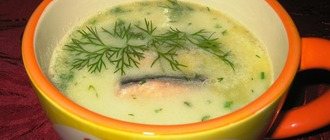The chopsticks used to eat food such as sushi are already familiar to even a child. Nowadays, only a lazy person or a person who is completely uninterested in Japanese cuisine has not tried to use them. However, few people know what sushi sticks are called and that they have a fairly rich history. This article is dedicated to these interesting devices for eating.
What are sushi chopsticks called?
A little history
Sushi sticks have now spread all over the world, but their original homeland is Asia. And before they looked a little different from how we know them now. Let's dive into the history of these products, which is quite interesting.
Leisurely eating in Japan
Historians report that the very first chopsticks that were used for eating appeared in China approximately 3,000 years ago . The Shang Dynasty was in power then. They were invented by Emperor Yu, who one fine day decided to get a hot piece of meat and used chopsticks for this. The length of the first products varied between 37-38 cm. For a long time they were used as kitchen utensils, and only after a certain period of time they began to eat with chopsticks - then their length became shorter (about 25 cm).
The very first sticks were made from ordinary bamboo - it was split into a couple of parts. One part was folded in half to create a kind of long tongs that could be used to pick up pieces of food.
The first sushi sticks were made from bamboo
From China, products gradually migrated to Japan (around the 12th century, when the Yayoi period lasted), where a whole culture appeared in relation to them. They came here in the same form as they were in China, but during the Asuka period, sticks appeared that were similar to modern ones, that is, divided. It is interesting that only aristocrats ate them, while the poor used their hands, but during the Nara period everyone began to eat them.
On a note! Beautiful sticks could be a wonderful gift for someone. For example, newlyweds in Japan were always given them with wishes of eternal love. The sticks were made from expensive materials, varnished, and beautiful patterns were applied to them.
Chopstick Museum in Shanghai
Chopsticks: rules of etiquette
Chopsticks are part of history and culture. Their use is surrounded by a lot of rules, conventions and ceremonies. There are many immutable traditions that relate to sticks. Here are the main ones:
- Chopsticks should not be stuck into food. Chopsticks stuck vertically into a bowl of food are associated with a method of offering to the dead;
- Do not knock chopsticks on the table or the edges of the plate;
- You cannot point at people with chopsticks - it is very impolite;
- You cannot transfer food from one chopstick to another. In the Japanese tradition, such a gesture is considered bad manners, because such an action is performed in a funeral ritual, where participants hand over the bones of the dead;
- Chopsticks should not be licked or held in the mouth for a long time;
- They do not pick at the plate with chopsticks or move them around the dish. Food should be taken from above;
- Food should not be scraped from the plate using chopsticks, nor should one lower one’s face down to the plate in a hurry to eat food;
- Never clench chopsticks in your fist; in Japanese culture such a gesture is threatening;
- The dishes should not be pulled towards the chopsticks;
- Do not shake or wave the chopsticks. It is also considered bad manners for liquid to flow or drip from chopsticks while eating;
- Never rub chopsticks together to remove splinters or splinters. If necessary, do this by hand;
- While eating, do not cross your chopsticks - this is another part of the Japanese funeral ritual;
- Do not use chopsticks as a knife or fork: they can only be used as a pair in one hand. If you need a knife, ask the waiter for it;
- Do not use chopsticks as a skewer or skewer;
- Do not place chopsticks across the bowl. After finishing your meal, place the chopsticks on a special stand or on the table with the sharp ends to the left.
Chopsticks are used for eating in Japan, China, Korea and Vietnam. At first you will find it difficult to handle this cutlery, but with practice, you will be able to use them without difficulty. You will be able to appreciate all the benefits of eating with chopsticks, because in restaurants of national cuisine, eating with them is much more pleasant and natural than using a knife, fork or spoon.
Modernity
Nowadays, not a single feast in Asian countries is complete without chopsticks. They are mainly used in China, Korea, and Japan. It is interesting that they were used for a long time in the land of smiles - Thailand, but then the king of the Thai kingdom, Rama V, decided to use eating utensils from Europe, and chopsticks began to be used less often - usually only for eating sushi or noodles. They are usually made traditionally from bamboo, maple, plum or cypress wood. And they can be either square or round in cross-section.
In Asian countries, not a single feast is complete without chopsticks.
Despite the fact that chopsticks are now actively used in many countries around the world, in Japan, eating with them is still a real ritual . And all dishes that are eaten with chopsticks are prepared in such a way that they do not have to be additionally cut by hand on the plate (for example, there are no bones in fish).
Japanese children begin to master the use of chopsticks almost from the cradle - it is believed that these devices can give a good workout to their hands and fingers and develop fine motor skills. Some children are able to use them for food already at the age of one year and are developmentally ahead of children who take food from a spoon.
Children master chopsticks from an early age
It is interesting that this item for eating can be male or female and, in general, is individual for each person. No one will give their chopsticks to anyone else. Chopsticks are almost a sacred symbol and should be treated with respect.
Interesting! When hired to work with small parts, a Japanese may be asked to quickly collect scattered beads using chopsticks as a test. And in some cases they can be a weapon - a correctly thrown stick can pierce through a solid object.
Today, chopsticks are almost a sacred symbol.
Chopsticks, which are used only once, are usually served in cafes and restaurants, packaged in individual paper covers. They can be made of plastic or wood. Moreover, the ends of the sticks will be sealed on top or under-split, so that it is clear that no one has used them before.
The chopsticks trick
There is an interesting belief - if, while breaking sticks, a person gets “uneven” breaks, that is, there is more wood left on one stick than on the other, then he should expect troubles in life.
Disposable Sushi Chopsticks
What types of sticks are there?
Hashi belongs to only one owner and is an integral attribute of Japanese cuisine. They are named in the same way as the corresponding hieroglyph that resembles them in appearance. Sushi sticks (called “hashi”) visually resemble a bamboo trunk split into two parts. To determine whether food was contaminated with poisons, silver instruments were used in the imperial palace of China. Sushi sticks, which were named by the Japanese, are now made from wood, metal, and ivory. Their cross-section can be square or round, and the tip can be pyramidal or conical.
Sushi chopsticks, called "waribashi", are considered disposable products. The material for them is wood or plastic. They are brought to customers in restaurants and sushi bars. And if the sticks are connected to each other, this indicates the novelty of the product and the high class of the establishment.
Warbashi must be broken before eating. In addition, they are usually served in a case with some beautiful pattern or logo of the establishment in which the sushi chopsticks are served. The name of the case is “Hashiburuko”. It is sometimes expensively and exquisitely decorated, making it capable of becoming a collector's item.
We have a sushi bar on almost every street, and it’s even becoming indecent not to know how to use chopsticks. But in fact, only a Japanese chef can prepare real sushi. Nowadays, to immerse yourself in the atmosphere of Japan, you can go to a good restaurant. In principle, it is believed that you can only feel the flavor of this amazing cuisine in its homeland. Despite this, an increasing number of restaurants are opening, offering corresponding dishes.
So what are they called?
There are several names - it all depends on what country the name is in. So, in China they are called “kuaizi”, in Korea – “chokkarak”, in Japan – “hashi”, but there are other names. Also, depending on the country in which they are used, the sticks may differ somewhat in appearance.
Chinese kuaizi
Chinese kuaizi are 25 cm long and square at the base - this shape is created so that they do not roll on the table surface. Those used to create culinary masterpieces will be 1.5 times longer than table ones. In China, they are made from wood, bone, plastic, and metal. Disposable wood products here are called weisheng kuaizi. They are cheap and not of good quality, and before use they need to be rubbed together to remove defects and avoid pricking themselves on possible splinters.
Chokkarak from Korea are made of metal, very thin. By the way, only in Korea are chopsticks made of metal. Stainless steel is usually used, although previously the sticks were made of brass.
Korean chopsticks (chokkarak)
In Japan, these devices are called hashi or o-hashi. The latest variation is a tribute to this talismanic symbol. The Japanese are very sensitive to chopsticks, and therefore, even just talking about them, they use a respectful form of the name. As mentioned above, each family member has his own khasis. There are also various sticks that are used on certain days - for example, on New Year's Day or for the tea ceremony.
Khasi – chopsticks for all occasions
On a note! There are hashi that were invented by Sen no Rikyu, a tea master. There are also simple wooden sticks - varibashi. This is a one-time variation.
Reusable products can be called nuribashi. So they can just resemble a real masterpiece, they are decorated in every possible way and can be presented as a gift.
Decorated nuribashi (reusable chopsticks)
Types of chopsticks
Khasi
- chopsticks that have a sole owner and are a traditional element of haute Japanese cuisine. They are made from ivory, wood, and metal. The hieroglyph “Hashi” in its appearance resembles a bamboo trunk split in two - these, in fact, were the first sticks in history.
Varibasi
— disposable cutlery that is offered to visitors of sushi bars and restaurants. Most often they are made of plastic or wood. They are connected at the end - this is a sign of good taste and evidence that no one used chopsticks. To start eating, the chopsticks should be broken.
There is also a special stand...
In order not to put hashi on the table, the Japanese came up with a special stand for them. It's called "Hashioki". The word was formed from the word “oku” - to put. The stand is used like this: the hashi is placed on it with its thin ends, and they should be oriented to the left.
Stand for chopsticks (hashioki)
On a note! If there is no stand on the table, then hashi can be placed directly on the surface of the table itself or on the very edge of the plate. There is no need to place them across it, since, according to etiquette, this gesture means that the person no longer wants to eat.
A Little-Known Option for a Chopstick Stand
There is another interesting term that applies to chopsticks. This is hashibukuro, but it’s not the sticks themselves that are called that, but the case in which they are packed.
Sushi chopsticks with cover
Sticks in the past and now
The history of feast sticks goes back more than three thousand years. They were invented by the Chinese (you can read more about this here), and later people liked the invention so much that it became popular not only in the Middle Kingdom. Today it is used everywhere in Asia, namely in its eastern part: in the Chinese, Japanese, Vietnamese, and Korean states.
In Thailand, chopsticks are used only when serving noodles and soup.
Initially, they looked like tongs, which were very useful for cooks and housewives when cooking. The technique for making such tongs was extremely simple: the bamboo stem was divided in two, and one part was bent in half. Using a simple device, they stirred the food, took out pieces for testing, and put them in portions for serving.
Their length was strictly 38-39 centimeters. For food, a shortened, 25-centimeter version was used.
Chopsticks came from the Middle Kingdom to Japan during the Yayoi period, at the junction of the last and our eras. Here they received their own name - Khasi. Khasi of the usual type for us - thin, double - appeared in the 7th century and could only be used by the upper class. They spread to the entire population only a century later, during the Nara period.
It is interesting that chopsticks were also used in fighting skills: in the hands of a real fighter who knows how to throw a weapon correctly, they are capable of destroying solid objects.
Japanese cuisine of our time is unique, and the ingredients in dishes are usually chopped finely, because here everything is eaten with hashi: rice, noodles, sashimi, and numerous snacks. Even soup is eaten in a special way: the broth is drunk from bowls, and the remaining ingredients are taken out with chopsticks.
Every year the Japanese use more than 25 billion pairs of hashi. Rough calculations show that this is almost two hundred devices per capita. It is curious that wood is mainly purchased from China and Russia, and 9 out of 10 sets of sticks are made in China.
How to use chopsticks?
Many people think that mastering the skills of using hashi is extremely difficult. But with proper practice and constant training, as well as understanding the principle of operation, they can be used easily and naturally.
How to use chopsticks
Step 1. The first thing you need to do is take one of the sticks in your right hand.
The stick is taken with the right hand
Step 2. The thickened end of the stick must be placed on the skin between the index finger and thumb. A correctly laid stick should protrude 3 cm beyond the edge of the hand.
A thick horse stick is placed between the index finger and thumb
Step 3. The opposite end of the hashi should be placed on the ring finger.
The other end is located on the ring finger
Step 4. The fingers should be freely bent - there should be no tension in the hand.
It is important that you don’t feel tension in your hand.
Step 5. The stick laid in this way will be considered the bottom. And success in using hashi in general will largely depend on how clearly it is recorded. You should make sure that the lower stick lies freely, but is securely secured with your fingers. This stick will not move while you eat.
The bottom stick won't move
Step 6. Use your thumb to press the bottom stick to your ring finger.
The lower stick is pressed with the thumb to the ring finger
Step 7. You can check if the bottom stick is holding correctly. If it is positioned correctly, then the index and middle fingers will also move freely, and the stick will remain in place.
Check if the bottom stick is held correctly
Step 8. Now you need to take the second stick and hold it between your adjacent fingers - thumb and index. You should press it with your fingertips. The stick can be rested on the side of the middle finger.
The second stick is clamped with your fingertips
Step 9. To take a piece of food, you just need to grab it with the ends of the products and fix them in them.
How to hold food with chopsticks
Video - How to use sushi chopsticks
How to use a set of chopsticks for beginners
Video - How to make expensive and beautiful sticks?
Sushi chopsticks - oriental style cutlery
Japanese chopsticks are very convenient to eat with, but it may take some time and effort to get used to them.
Japanese restaurants are very popular these days. Here you can eat delicious rolls and other types of sushi, drink a decanter of sake, and listen to national Japanese music. Many people respect the strict style and aesthetics of the Land of the Rising Sun.
The Japanese eat with special wooden chopsticks; we call them “sushi chopsticks,” “Japanese chopsticks,” or simply “chopsticks.”
The Japanese call sushi chopsticks the word “hashi”; it is their main cutlery. By the way, with practice you can learn to eat with their help very quickly.
The Chinese, for example, are able to eat rice with chopsticks so deftly that not any European with a fork can keep up with them.
However, such cutlery is not very familiar to Europeans; it takes a lot of practice. In addition, chopsticks are not very suitable for some dishes, such as soups or certain types of salads. But now it is fashionable and, moreover, quite convenient; more and more Europeans are actively mastering Japanese chopsticks.
Cafes and restaurants usually serve disposable wooden chopsticks of the simplest design. However, if they like the cutlery, many clients take them home. Although it is better to purchase high-quality sushi chopsticks for home use, aesthetics are still very important in this case.
There are sticks made of metal, usually steel; more exotic options are used less often - silver, for example. But the problem is that they are more difficult to use than the wooden version; it is very difficult to grasp and hold a piece of food with slippery chopsticks.
Rules of etiquette
Chopsticks must be treated with respect and be sure to remember all the rules of etiquette associated with them. It is especially important to study this if you are planning a trip to Japan or another Asian country. Breaking the rules can seriously offend people who use hasi with all due respect.
- Chopsticks can only be used to move food on a plate or bring it to the mouth. They can no longer be used in any way. Breaking food or picking at it with hashi is also prohibited.
- They cannot be knocked on the plate or on the table.
- If a person touches a piece of food with a chopstick, then he must eat it.
- Shaking chopsticks, especially with a piece of food between them, is not allowed.
- Licking and sucking them is prohibited. They also cannot be waved.
- When using hashi, you cannot turn your hand over with your wrist up - this is uncivilized.
- You cannot give your chopsticks to anyone.
- Under no circumstances should you clasp them tightly in your fist - Japanese residents regard this gesture as a threat.
Rules for using sushi chopsticks
Khasi: cutlery or something more?
If for most people chopsticks are an ordinary device for eating, then for the Japanese they are a kind of sacred symbol that promises good luck and longevity. For the same reason, transferring them to someone else's use is a bad omen. Among other things, there is an opinion that the ability to handle hashi perfectly trains small muscles and contributes to the development of mental abilities. This is why children in Japan are instilled with the desire to master chopsticks from an early age. Not so long ago, this statement received scientific proof: scientists have proven that children who began to use hashi at the age of one are significantly ahead in their development of their peers who did not want to part with a spoon.
By the way, mastering the art of using chopsticks will also be useful for adherents of Japanese culture who want to learn how to properly stir sauce, hold food, chop and cut it into small pieces that are convenient to put in the mouth.
Khasi and the environmental situation
Whatever one may say, the use of khasi for food has a significant impact on the environmental situation in the regions where they are actively used.
Table. Numbers and data.
| Index | Meaning |
| Wood consumption (as material) | 1.7 million m3/year |
| Number of trees | 25 million for 1 year |
| Export abroad | 180 billion pairs in 1 year |
| Number of disposable products used in Japan | 24 billion pairs in 1 year |
On a note! Since 2006, China has introduced a special tax on chopsticks. Approximately 5% of sales of these devices is paid to the treasury. And some hotels have completely abandoned their use.
The use of chopsticks seriously affects the environment
. Thus, despite the fact that sushi chopsticks are a very interesting and indispensable device for eating this dish, it is best to get reusable chopsticks at home and save the environment.
Fortunately, you can now buy them in almost any store, and in some places they sell very beautiful sets for the whole family. As for the name, now everyone who has read this material knows the correct name for sushi chopsticks, and may well begin to use Japanese terminology. 5/5 (8)
Individual item
Every lover of Japanese cuisine, of course, is interested in what sushi chopsticks are called in their homeland. It is all the more remarkable that in Japan many household items are divided depending on the gender of the consumer. Men do not use feminine objects, and the fair sex does not use masculine ones.
Chopsticks for every Japanese are a purely individual item that is never passed on to anyone else. Even members of the same family do not take them from each other. Khasi is always presented to newlyweds, imbuing the gift with the meaning of the couple’s inseparability.
Chopsticks are mainly used in Japan, Korea, China, and Vietnam. In Thailand, in the 19th century, cutlery from Europe was introduced into circulation, and chopsticks began to be used only for soups and noodles.
Reasons for loving chopsticks
Three thousand years have passed, progress has stepped far forward, and the Japanese still eat with chopsticks. They themselves claim: it is impossible not to love Khasi, because this is the path to health, slimness, intelligence, and manual dexterity. Indeed, the Japanese have many reasons to use this particular cutlery:
- Tribute to the past
The use of hashi, especially bamboo, takes the conservative inhabitants of Japan several centuries back to their ancestors. This way they can follow the traditions of their ancestors even in the culture of eating food, which, by the way, has also changed little over the years.
- Convenience
Chopsticks take up much less space than regular cutlery. Their production costs less, and natural materials are used. The Japanese say that wooden chopsticks do not change the taste properties of food, as metal does, but on the contrary, they give it even more taste.
- Benefit
When a person eats with chopsticks, he cannot take more than he can swallow. He eats more slowly, in small pieces, chews thoroughly and as a result becomes full faster. Perhaps this is the secret of Japanese slimness.
- Health
Asian doctors, after conducting a series of studies, came to an amazing conclusion: while eating, Khashi massage their hands, thereby influencing four dozen important points of the human body.
- Mind
Other observations have shown that children who, from an early age, learn to eat hashi rather than with a spoon, develop faster and show better mental abilities than their peers.
- Great gift
Khasis are loved so much that they are very happy to accept them as a gift. There are special types for tea ceremonies, New Year, weddings, and birthdays. In each case, the presentation of khasi is very symbolic - it promises success and longevity.
New couples are given a beautiful set of hashi so that they are not separated, like a pair of chopsticks. On the hundredth day after birth, the baby is given a ceremony for the first taste of rice and given symbolic hashi.
In addition, the market is replete with special sets for the whole family. So if you don’t know what to give to a lover of the East, this will be a wonderful present.
Types of Khasi
Today, chopstick manufacturers in Japan, when thinking through the design of a product, use all their imagination: they are painted, made into patterns, small carvings, varnished, and sprayed. The cut sticks can be round or square, and their tips can be in the form of a cone or pyramid, sharp or not very sharp.
The quality of hashi depends on what it is made from. So, they are made from different materials:
- bamboo;
- cypress;
- maple;
- sandalwood;
- plums;
- bones;
- metal;
- plastic.
Tea guru Sen No Rikyu, of Japanese origin, made his own type of hashi. There is a small legend associated with him. One day, at dawn, the master went into the forest to get firewood. He wanted to enjoy the unique woody smell, and began to clean pieces of wood - this is how his sticks appeared.
Sen No Rikyu
